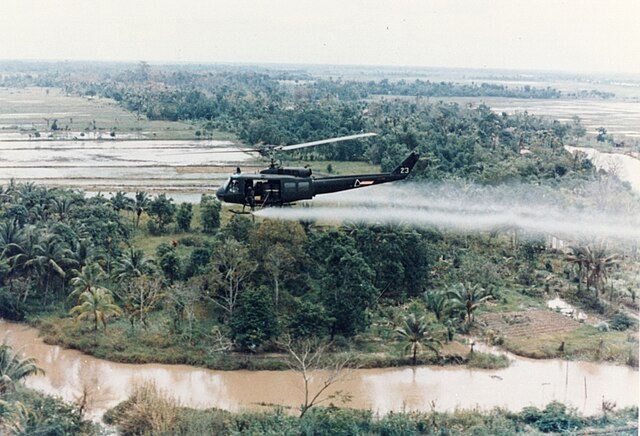
What is Agent Orange? Agent Orange is a herbicide that is also a defoliant. That means it makes trees lose their leaves.
Agent Orange got its name because the 55 gallon barrel it was stored in had an orange band around it. The US military used several different types of herbicides and they all had a different color on the barrel to identify them. There was Agent Orange, Agent White, Agent Blue, Agent Purple, Agent Pink, and Agent Green. The Agent sounds pretty cool, but it didn’t mean an agent for a service such as the CIA, it meant a chemical agent. An agent is a chemical that produces a reaction. Each one of the different colors was a different chemical, but they were all herbicides and defoliants.
The US military put a lot of money into research and funding for these herbicides in the Vietnam War. The chemicals had been found and developed during World War 2, but they were only really put into use during the Vietnam War. There were two purposes behind them. The first was a “scorched earth” policy. The enemy combatants had to live off the land, so destroying the crops on the land, and destroying the land to such an extent that it could no longer produce crops would starve out the enemy. Scorched earth has been used through the history of warfare. A retreating army would often destroy everything so that the invaders didn’t have any food. However, a scorched earth policy from the skies using chemicals is new. The second reason was to remove the foliage from the trees. The enemy forces hid in the jungle and used guerrilla warfare tactics. If there was no jungle left, then they would have nowhere to hide.
Out of all of the colors that were used by the US army during the Vietnam War, Agent Orange is the one that has become synonymous with that war. What was in it? Agent Orange is a herbicide that was made of two chemicals: 2,4-dichlorophenoxyacetic acid and 2,4,5-trichlorophenoxyacetic acid. The second of these two chemicals contained a dioxin called 2,3,7,8-tetrachlorodibenzo-p-dioxon (TCDD), and this is the most dangerous part of the herbicide. The idea of a herbicide is obviously to kill plants. “Herb” means plant and “cide” comes from Latin and means killer. It’s the same “cide” in suicide, regicide, and infanticide. The two chemicals in Agent Orange kill plants by imitating growth hormones in plants. When they do this, they trick the plant into growing so rapidly that it goes out of control and it dies. They can also interrupt the hormones that keep the leaves attached to the plant, making the leaves drop off. Similar to what happens to trees in the fall. Herbicides have been used for a long time in agriculture to control weeds.
In the Vietnam War, Agent Orange was liberally sprayed across large sections of the jungle. The US military sprayed over 43 million liters of Agent Orange over an area of jungle roughly 30,000 km2. That is about the same size as Belgium. Another 30 million liters of other herbicides (all the other color agents) were also sprayed. The Vietnamese government says that there were 26,000 villages in that area. The herbicide did its job and devastated the forest it was sprayed over. The US military probably only thought about the short term, which was the war. However, the consequences have been long term. The trees died and rather than growing back after the war, they were displaced by other invasive species. The lack of trees removed the ground cover and erosion from rain became a problem. Then all of the animal species that relied on the ecosystem died or left as well. The effects of the Agent Orange spraying can still be seen today.
Another unseen effect was the human one. It turns out that TCDD, the trace element in Agent Orange, is incredibly hazardous to people. TCDD enters the body very easily and once there is causes a lot of problems. It is a dioxin, which are molecules that can damage cells, organs, the immune system, and hormones. It causes a number of different cancers. It causes diseases of the heart, leukemia, diabetes, Parkinson’s, and other brain illnesses. It is estimated that 300,000 US soldiers and over 400,000 Vietnamese people died as a result of exposure to Agent Orange. There is no way of knowing the exact number because a lot of the Vietnamese people wouldn’t have been in a position to go to a hospital. With hindsight (and perhaps something that should have been obvious at the time), spraying Agent Orange on the Vietnamese jungle seems like a terribly bad decision. And this is what I learned today.
Sources
https://my.clevelandclinic.org/health/symptoms/24689-agent-orange-effects
https://en.wikipedia.org/wiki/Agent_Orange
https://www.ncbi.nlm.nih.gov/books/NBK209597
https://www.publichealth.va.gov/exposures/agentorange
https://www.etymonline.com/word/Agent%20Orange
https://en.wikipedia.org/wiki/Herbicidal_warfare
https://en.wikipedia.org/wiki/Agent_White
https://en.wikipedia.org/wiki/Agent_Blue
https://en.wikipedia.org/wiki/Agent_Purple
https://en.wikipedia.org/wiki/Agent_Pink
Image By US Army – https://www.vietnam.ttu.edu/virtualarchive/items.php?item=VA042084Item Number: VA042084, Public Domain, https://commons.wikimedia.org/w/index.php?curid=11434195
